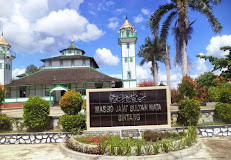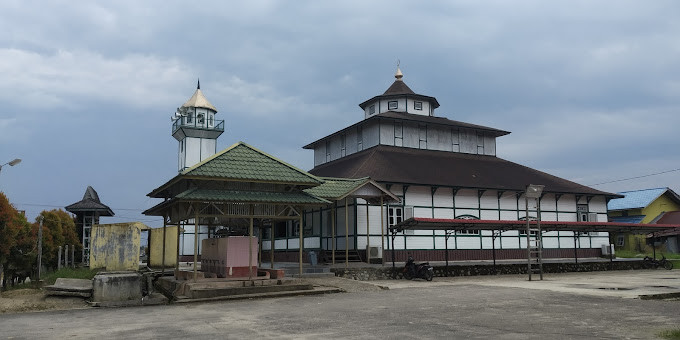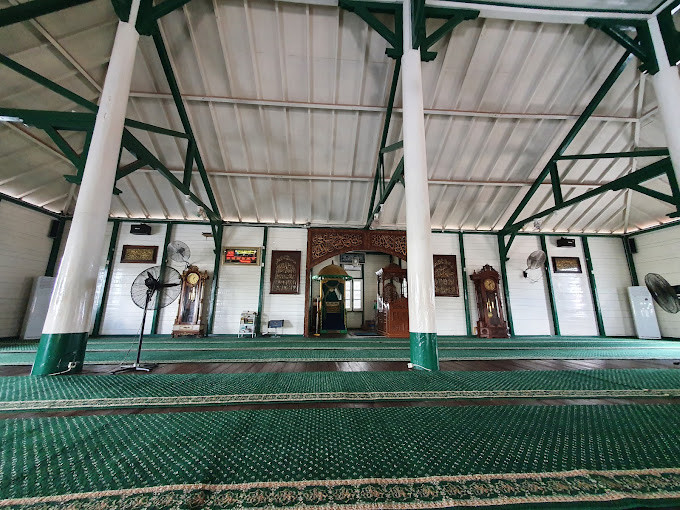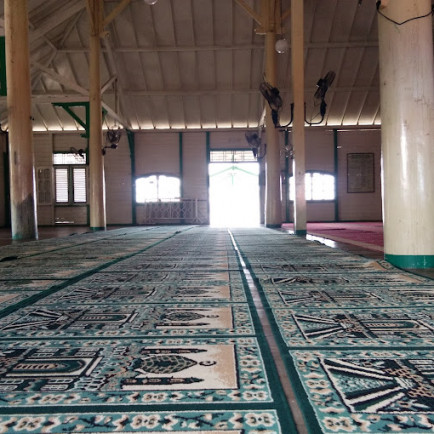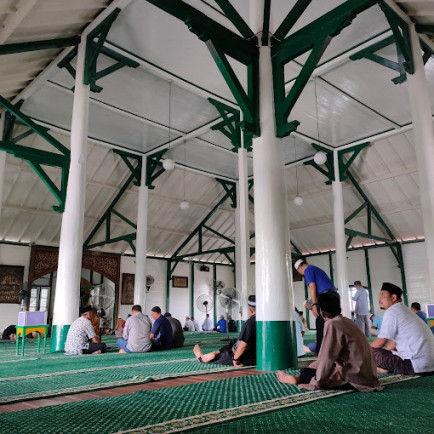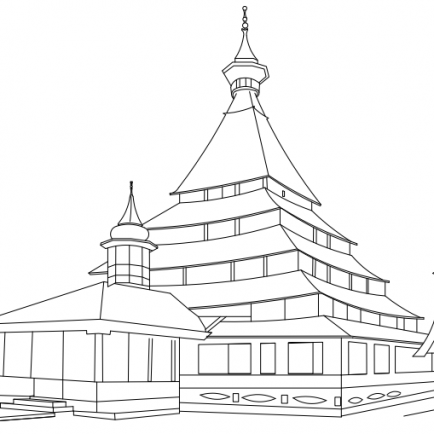Jami Mosque of Sintang
History
The mosque was instrumental in the spread of Islam in Sintang. During the reign of Pangeran Agung, the 17th Raja of Sintang, Islam became the official religion of the kingdom, replacing the former official religion of Hinduism. However, at that time, Sintang did not have a mosque. The learning of Islam was still held in the palace complex balai kerajaan. Pangeran Tunggal, the son of Pangeran Agung, decided to build a small-sized mosque with a capacity of 50 people. This small mosque is the forerunner of the Jami Mosque of Sintang.
During the reign of Sultan Nata Muhammad Syamsudin (19th Sultan of Sintang, the first ruler to use sultan as his title), this small mosque was expanded to become the main mosque of the Sintang Sultanate. The mosque was inaugurated on Muharram 12, 1083 AH (corresponds to May 9, 1672). During the reign of Sultan Abdurrasyid Muhammad Jamaludin (21st Raja of Sintang), the mosque was renovated and expanded. The Jami Mosque of Sintang has become an official place of religious activities in the Sultanate of Sintang. During the reign of Raden Abdul Bahri Danu Perdana al-Mukaram (1935), two minarets were added to the left and right of the mosque.
In 1987, the mosque was officially named Jami Mosque Sultan Nata Sintang after the founder of the mosque.
Urban and Architectural
The Sultan Nata Mosque uses the architecture of a typical stilt house on the river coast . The construction of the mosque building is made entirely of wood. The foundations, building frames, boom beams, roof cladding, and floorboards are made of purchased wood. The Sultan Nata Mosque has actually undergone several renovations, but the eight pillars made of purchased wood have been preserved in their original form until now. The pillar in the form of a cylindrical wood as high as more than 10 meters is still standing strong even though it has exceeded three centuries of age. There is a story wrapped in mysticism about this pillar. Circa 1997, when the Kapuas River receded, a water source appeared from one of the pillars which was said to be able to heal, so that people flocked to drink it. But unfortunately, at this time, the water source has been closed.
This mosque building has three roofs. The first and second roofs are shaped like limas, while the third roof is shaped like an octagonal cone. This conical roof shape is also used on the roof of the two twin towers that are next to the mosque. Every part inside the mosque is wrapped in white paint with a few green lines in some parts, such as on the windows, the base of the pillars, and the walls. As a decorative sweetener, the curtain covering the window was chosen to be yellow, a typical Malay color. While in the corner of the mosque, there are hundreds of years old drums made from a whole tree. After the renovation in 2000, this mosque is equipped with a large grass garden, decorated with shady palm trees .
At the front of the mosque, a wooden pedestrian bridge was also built that connected the mosque and the palace which were separated by a paved road. Since that year, this mosque has been designated as a cultural heritage site in Sintang Regency. In this mosque, visitors can witness the composition of the Sintang Kingdom religious leaders/ministers from time to time. Apart from that, the takmir of the mosque also provides a simple book that tells the history of the founding of the mosque and the renovations that have been carried ou
Description
Jami Mosque of Sintang also known as Sultan Nata Mosque is a mosque located in Sintang, West Kalimantan, Indonesia. The mosque is located within the complex of Istana al-Mukarrammah, the main palace of the Sultanate of Sintang, a kingdom in Sintang which existed since the 13th-century.
References
https://en.wikipedia.org/wiki/Jami_Mosque_of_Sintang
https://id.wikipedia.org/wiki/Masjid_Jamik_Sultan_Nata
Details
Location
Sintang, West Kalimantan, Indonesia
Worshippers
500
Owners
Indonesian Mosque Council
Architect Name
Year of Build
1672
Area
800
Drawings
Map
History
The mosque was instrumental in the spread of Islam in Sintang. During the reign of Pangeran Agung, the 17th Raja of Sintang, Islam became the official religion of the kingdom, replacing the former official religion of Hinduism. However, at that time, Sintang did not have a mosque. The learning of Islam was still held in the palace complex balai kerajaan. Pangeran Tunggal, the son of Pangeran Agung, decided to build a small-sized mosque with a capacity of 50 people. This small mosque is the forerunner of the Jami Mosque of Sintang.
During the reign of Sultan Nata Muhammad Syamsudin (19th Sultan of Sintang, the first ruler to use sultan as his title), this small mosque was expanded to become the main mosque of the Sintang Sultanate. The mosque was inaugurated on Muharram 12, 1083 AH (corresponds to May 9, 1672). During the reign of Sultan Abdurrasyid Muhammad Jamaludin (21st Raja of Sintang), the mosque was renovated and expanded. The Jami Mosque of Sintang has become an official place of religious activities in the Sultanate of Sintang. During the reign of Raden Abdul Bahri Danu Perdana al-Mukaram (1935), two minarets were added to the left and right of the mosque.
In 1987, the mosque was officially named Jami Mosque Sultan Nata Sintang after the founder of the mosque.
Urban and Architectural
The Sultan Nata Mosque uses the architecture of a typical stilt house on the river coast . The construction of the mosque building is made entirely of wood. The foundations, building frames, boom beams, roof cladding, and floorboards are made of purchased wood. The Sultan Nata Mosque has actually undergone several renovations, but the eight pillars made of purchased wood have been preserved in their original form until now. The pillar in the form of a cylindrical wood as high as more than 10 meters is still standing strong even though it has exceeded three centuries of age. There is a story wrapped in mysticism about this pillar. Circa 1997, when the Kapuas River receded, a water source appeared from one of the pillars which was said to be able to heal, so that people flocked to drink it. But unfortunately, at this time, the water source has been closed.
This mosque building has three roofs. The first and second roofs are shaped like limas, while the third roof is shaped like an octagonal cone. This conical roof shape is also used on the roof of the two twin towers that are next to the mosque. Every part inside the mosque is wrapped in white paint with a few green lines in some parts, such as on the windows, the base of the pillars, and the walls. As a decorative sweetener, the curtain covering the window was chosen to be yellow, a typical Malay color. While in the corner of the mosque, there are hundreds of years old drums made from a whole tree. After the renovation in 2000, this mosque is equipped with a large grass garden, decorated with shady palm trees .
At the front of the mosque, a wooden pedestrian bridge was also built that connected the mosque and the palace which were separated by a paved road. Since that year, this mosque has been designated as a cultural heritage site in Sintang Regency. In this mosque, visitors can witness the composition of the Sintang Kingdom religious leaders/ministers from time to time. Apart from that, the takmir of the mosque also provides a simple book that tells the history of the founding of the mosque and the renovations that have been carried ou
Description
Jami Mosque of Sintang also known as Sultan Nata Mosque is a mosque located in Sintang, West Kalimantan, Indonesia. The mosque is located within the complex of Istana al-Mukarrammah, the main palace of the Sultanate of Sintang, a kingdom in Sintang which existed since the 13th-century.


